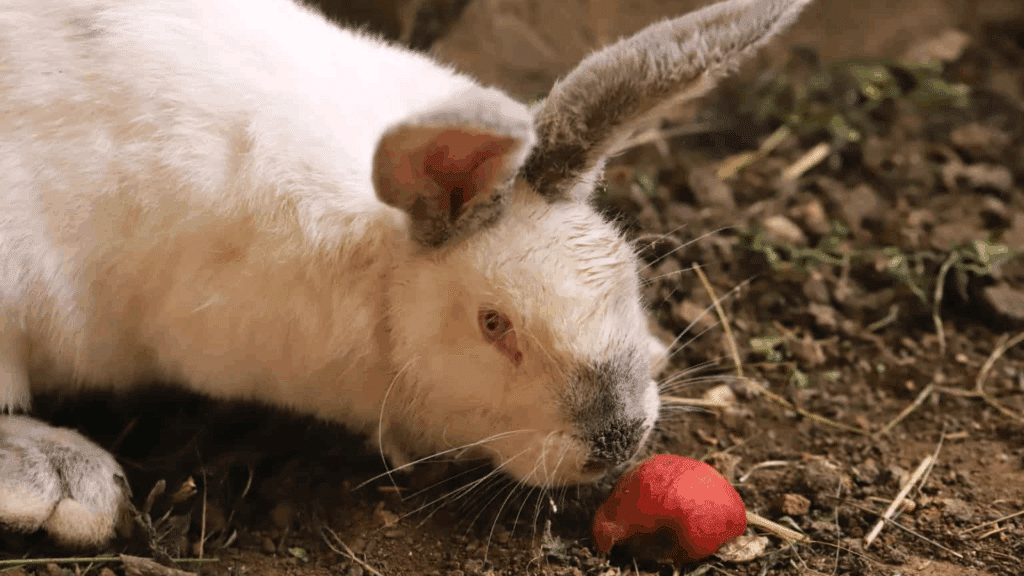Many rabbit owners wonder if radishes make a safe and healthy snack.
Rabbits love crunchy foods, but not every vegetable is good for them in large amounts. Radishes might look harmless, yet they can cause trouble if fed the wrong way or too often.
This post breaks down everything you need to know before giving your bunny a bite. You’ll learn:
- If rabbits can eat radish roots and greens
- Signs your rabbit may have eaten too much
- Safer veggie options to try instead
By the end, you’ll know exactly how to add radishes to your rabbit’s diet the right way, without upsetting their stomach.
Let’s look at what makes this crunchy veggie both tempting and tricky for rabbits.
Can Rabbits Eat Radishes?
Yes,rabbits can eat radishes, but only in small amounts. From what I’ve seen with my own rabbits, they enjoy the crunchy texture, but moderation is key.
You can feed both the radish root and the greens, as long as they’re clean and fresh.
Radishes are high in fiber, which helps with digestion, but too much can lead to gas or bloating. I usually give just a thin slice or a few greens at a time.
If you notice your rabbit acting uncomfortable or eating less hay afterward, it’s best to stop and go back to their regular food. Think of radishes as a small treat, not a main part of their diet.
That way, you can keep your rabbit happy and healthy without upsetting their stomach.
Health Benefits of Feeding Radishes in Moderation

Radishes can be a healthy treat for your rabbit when fed in small, controlled amounts. They’re not meant to replace hay or leafy greens, but they do offer a few real benefits when added to a balanced diet.
Rabbits enjoy their crisp texture, and with the right portion, radishes can support both digestion and hydration. This is how they help when given in moderation:
- Fiber for digestion: Radishes are rich in fiber, which helps your rabbit’s digestive system work properly. Fiber keeps their gut moving and prevents constipation or slow digestion.
- Vitamin C: Although rabbits make their own vitamin C, the extra boost helps with immune support and overall health, especially during mild stress or seasonal changes.
- Water content: Radishes contain a lot of water, which helps keep your rabbit hydrated and supports kidney health.
- Crunchy texture: The firm bite of a radish helps wear down their teeth naturally, which grow continuously.
How to Prepare Radishes for Your Rabbit?
When I prepare radishes for my rabbits, I keep it simple and safe. First, wash the radishes well to get rid of any dirt or pesticides.
I always make sure they’re fresh and clean before feeding. Next, slice them into thin pieces so your rabbit can chew them easily. Never cook or season them; serve radishes raw only.
Rabbits don’t need salt, butter, or any added flavor. I usually start with a small slice the first time to see how my rabbit reacts.
If they eat it without any signs of discomfort, such as gas or bloating, you can offer it again later as a small treat.
Always remove any uneaten pieces after a few hours to keep things fresh. Remember, radishes are best given in moderation, just a few bites at a time.
Keeping the portions small helps your rabbit enjoy the crunchy texture without upsetting their stomach.
Signs Your Rabbit Ate Too Many Radishes
Rabbits can be sensitive to new foods, and radishes are no exception. Some bunnies can handle them well, while others might show signs of discomfort if they eat too many.
It’s important to watch your rabbit closely after introducing radishes to their diet. This is what to look for:
- Bloating: a swollen belly or signs of discomfort after eating.
- Soft or runny stools: a common sign of too much fiber or spiciness.
- Less appetite: skipping hay or favorite greens could mean their stomach feels upset.
- Low energy: acting tired or sitting still more than usual.
- Gassiness: rabbits might shift around or press their belly to the ground.
- Avoid radishes next time: if your rabbit refuses them later, it could be a sign they caused discomfort.
If you notice any of these signs, stop feeding radishes and stick to gentle greens for a few days.
Safer Vegetable Alternatives to Radishes
There are many vegetables safer and gentler for rabbits than radishes. I like to rotate these to keep their diet healthy and balanced. Below are some great choices you can add to your rabbit’s meal plan, along with their benefits.
1. Romaine Lettuce
I often feed romaine lettuce because it’s one of the safest leafy greens for rabbits. It’s packed with fiber, which helps keep their digestive system running smoothly, and has a high water content that supports hydration.
Romaine also contains vitamins A and K, both important for good vision and bone strength.
I usually offer a few leaves daily, mixing them with other greens. It’s light on the stomach and doesn’t cause gas or bloating like some other lettuces, such as iceberg.
2. Cilantro
Cilantro is one of my rabbits’ favorite herbs, and it’s full of nutrients that support their overall health. It provides vitamin A, which keeps their coat shiny and eyes healthy, and vitamin K for strong bones.
Cilantro also has a gentle flavor that most rabbits love, making it a great way to encourage picky eaters. I usually feed a small handful every other day.
It also helps freshen their breath naturally, which is a small but welcome bonus.
3. Parsley
I like to give parsley once or twice a week because it’s rich in vitamins C and K and provides antioxidants that support the immune system.
It also contains calcium, which helps build strong bones and teeth, but that’s why it should be given in moderation. I usually mix a few sprigs with softer greens like romaine or cilantro.
The scent of parsley tends to excite my rabbits, making it a great addition when they seem less interested in their usual food.
4. Bell Peppers
Bell peppers are a colorful, crunchy treat that most rabbits enjoy. I prefer red and green ones because they’re packed with vitamin C, which helps protect against illness and boosts immune health.
They’re also full of fiber and antioxidants, both important for digestion and cell health.
I always remove the seeds and white parts before feeding. A few thin slices make a great low-sugar snack, and their high water content helps keep your rabbit hydrated, especially in warmer months.
5. Bok Choy
Bok choy is one of the mildest vegetables I feed my rabbits. It’s easy on their stomach and rich in vitamins A, C, and K. It also provides calcium and fiber, both helpful for strong bones and good digestion.
I usually chop it into small pieces and mix it with other leafy greens.
Its soft texture makes it great for younger or older rabbits that don’t like tough vegetables. Just make sure it’s fresh and washed well before serving.
Tips for Introducing Radishes into a Rabbit’s Diet
Introducing new foods to your rabbit’s diet should always be done slowly and carefully. Radishes can be safe, but every rabbit reacts differently. These are a few tips to make the process easy and safe for your pet:
- Start small: Offer just one thin slice of radish the first time.
- Watch for 24 hours: Keep an eye on your rabbit’s appetite, droppings, and energy.
- Mix with other greens: Combine the radish with familiar vegetables like romaine or cilantro.
- Avoid daily feeding: Offer radishes only once or twice a week as a treat.
- Check for stomach issues: Look for signs like gas, bloating, or soft stools.
- Keep portions tiny: A few small pieces are enough for most rabbits.
- Always serve fresh and raw: Never cook or season radishes before feeding.
A slow, gentle introduction helps prevent tummy issues and keeps your rabbit healthy.
Conclusion
Radishes can be a fun, crunchy treat for your rabbit when fed in small amounts. They add a bit of variety to your pet’s diet and can even offer some healthy nutrients like fiber and vitamin C.
Still, moderation matters; too many radishes can upset your rabbit’s stomach and cause gas or bloating. I’ve found that a thin slice once or twice a week is plenty.
Always wash them well and keep their main diet focused on hay, leafy greens, and water.
A healthy rabbit isn’t about fancy foods; it’s about simple care, safe choices, and paying attention to what works best for your pet.
Balanced diets and caring owners make the biggest difference in keeping rabbits happy, active, and well-fed.








